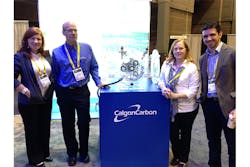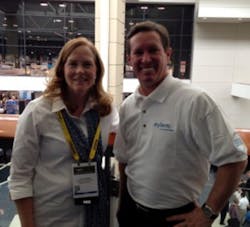Heading to the Water Environment Federation Technical Exhibition and Conference (WEFTEC) in September, I was excited to reconnect with old friends and to meet new ones, and I was not disappointed. I saw familiar faces at many of the exhibitor booths and met new friends (like Calgon Carbon’s team, see Image 1) and Xylem Inc.’s President and CEO Patrick Decker (see Image 2). One thing was evident: The water industry is innovative and growing in new directions.
Image 2. Editor Lori Ditoro with Xylem Inc.’s President and CEO following their podcast about Xylem’s charitable organization Xylem Watermark.
According to the WEFTEC Daily from Sept. 29, 2015, the song "Revolution" played as WEF President Ed McCormick began his welcome. That is because the water industry is experiencing a revolution that Water Technology first discussed following the American Water Works Association Annual Convention & Exposition’s Opening Session. This revolution is also behind WEFTEC 2015’s theme: One world. One water. One event. Treating all water as a resource is critical to ensuring clean water for the future, and reuse, particularly in industrial processes, is one of many changes underway. Specific to this mind change, during the past 18 months, "WEF has changed the term ‘wastewater treatment’ to ‘water recovery facilities.’" Reuse is becoming the norm in industrial settings, agricultural applications, some municipal facilities and in areas of water scarcity.
Of course, water treatment is at the center of what we cover in Water Technology. In this issue, our cover series includes articles that detail the removal of toxins, pathogens and aesthetic contaminants (see page 16). In addition, Dr. Joe Cotruvo, in his "Contaminant of the Month," covers an emerging problem with microbeads, found in personal care products and currently prolific, specifically in the Great Lakes (see page 10).
As we near next month’s last issue of the year, remember to email us and let us know what you would like to see in our pages next year.

